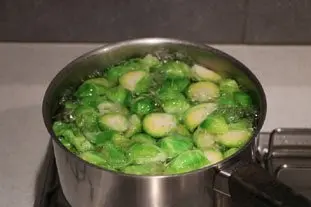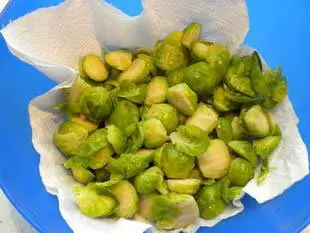This site uses only a few technical cookies necessary for its operation. By continuing to browse, you accept their use.
To find out more...
To find out more...
Double cooking of vegetables

When you cook vegetables, it's not easy to capture and preserve the flavours.
It is easy to undercook, but you can make up for it, or overcook, and then it is unfortunately a bit cooked (in the sense of "ruined").
But above all, how to get the maximum of the taste of the vegetable in the pan, then in your plate, and not in the air of the kitchen or the cooking water?
It's not easy, many cooks will tell you that cooking meat is relatively simple, but that vegetables...
It is easy to undercook, but you can make up for it, or overcook, and then it is unfortunately a bit cooked (in the sense of "ruined").
But above all, how to get the maximum of the taste of the vegetable in the pan, then in your plate, and not in the air of the kitchen or the cooking water?
It's not easy, many cooks will tell you that cooking meat is relatively simple, but that vegetables...
25 K 4.1/5 (27 reviews)
Keywords for this post:CookingVegetablesBoiling waterSaltDoubleTipLast modified on: July 12th 2019
Double cooking of vegetables
Add to all this that, in addition, it is difficult to generalize, that is to say that for such and such a vegetable it is better to do like this while for others it is better to do like that.
But rather than discuss it, I'll take an example with Brussels sprouts, which are tasty vegetables (but that it is easy to completely mess them up by overcooking them, like at the canteen when you were little).
Peel, cut in 4 if the cabbages are big to have pieces not bigger than a sugar cube, and wash with water.
2) First cooking
The cabbages are plunged into a large volume of salted water (1 tablespoon of coarse salt per litre of water), and cooked until they are tender, but not melting, it is very important
3) Cool quickly
Remove the cabbages from the cooking water with a skimmer and plunge them into very cold water, to stop cooking immediately, then drain carefully.
Note that the cooking water at this point is no longer simple salt water, it is already starting to be a vegetable broth, and you should keep it in the fridge after cooling, for other cooking of other vegetables.
4) Second cooking
In a saucepan or a frying pan, heat a large knob of butter or a little olive oil, once hot, add a finely chopped shallot, salt and pepper and cook for 1 minute, without colouring. Then add the vegetables, well drained, and cook for 2 or 3 minutes, hardly more. Serve immediately.
If you don't know, or have never practiced, you might be very surprised by the delicate taste of the vegetables treated this way. Making for example a dish with 3 or 4 different vegetables, in season, with this method, will give you a rather simple dish, just vegetables, but also exceptional in taste and finesse.
- For the seasoning, just salt and pepper you have seen, but some finesse is quite possible, like a little fleur de sel just before serving, or a sophisticated pepper.
- Obviously, and as always, it is much better with seasonal vegetables.
To sum up: The next time you have vegetables to cook, try the double cooking, boiling salted water, then pass in shallot, or onion, sautéed in butter or olive oil.
Insoluble?
No, not exactly, in fact there is a method that gives very good results for almost all vegetables, it is the double cooking.How does it work?
The general principle is that we cook a first time in boiling salted water (cooking called"A l'anglaise", by the French), then a second cooking with a little fat, butter or oil for example according to your taste. This double cooking, even if it is a little longer, is the quasi insurance of a taste of the vegetable revealed and preserved.But rather than discuss it, I'll take an example with Brussels sprouts, which are tasty vegetables (but that it is easy to completely mess them up by overcooking them, like at the canteen when you were little).
The double cooking of Brussels sprouts
1) Peel and wash
Peel, cut in 4 if the cabbages are big to have pieces not bigger than a sugar cube, and wash with water.
2) First cooking

The cabbages are plunged into a large volume of salted water (1 tablespoon of coarse salt per litre of water), and cooked until they are tender, but not melting, it is very important
3) Cool quickly

Remove the cabbages from the cooking water with a skimmer and plunge them into very cold water, to stop cooking immediately, then drain carefully.
Note that the cooking water at this point is no longer simple salt water, it is already starting to be a vegetable broth, and you should keep it in the fridge after cooling, for other cooking of other vegetables.
4) Second cooking

In a saucepan or a frying pan, heat a large knob of butter or a little olive oil, once hot, add a finely chopped shallot, salt and pepper and cook for 1 minute, without colouring. Then add the vegetables, well drained, and cook for 2 or 3 minutes, hardly more. Serve immediately.
If you don't know, or have never practiced, you might be very surprised by the delicate taste of the vegetables treated this way. Making for example a dish with 3 or 4 different vegetables, in season, with this method, will give you a rather simple dish, just vegetables, but also exceptional in taste and finesse.
Some more info-
For an even more delicate taste, use instead of boiling water, a vegetable or poultry stock.- For the seasoning, just salt and pepper you have seen, but some finesse is quite possible, like a little fleur de sel just before serving, or a sophisticated pepper.
- Obviously, and as always, it is much better with seasonal vegetables.
To sum up: The next time you have vegetables to cook, try the double cooking, boiling salted water, then pass in shallot, or onion, sautéed in butter or olive oil.
Lasts posts
Butter vs. grease
We often read in a recipe where a pastry is put into a mould that, just before pouring, the mould should be buttered or greased. But what's the difference between these 2 terms?December 1st 20251,7615
Getting out of the fridge early
Very often when you're cooking, you need to take food or preparations out of the fridge, to use them in the recipe in progress. There's nothing tricky about this: you just take them out of the fridge and use them, usually immediately, in the recipe. But is this really a good method?November 24th 20251,3395
Who's making the croissants?
When you look at a bakery from the outside, you naturally think that in the bakery, the bakers make the bread, and in the laboratory, the pastry chefs make the cakes. It's very often like that, with each of these professions having quite different ways of working, but sometimes there's also one...November 23th 20251,233
Oven height
When we put a dish or cake in the oven, we naturally tend to put it on the middle shelf, and that's what we usually do. But in some cases, this position and height can be a little tricky, so let's find out why.October 8th 20253,6345
The importance of sieving
In recipes that use a fine powder (flour, powdered sugar, etc.), you'll often see the advice to sift before using it. To sift is to pass the powder in question through a sieve (a very fine strainer) before incorporating it into your recipe. It's often advice, but is it really useful?September 3rd 20258,1413
Other pages you may also like
Coarsely chopped herbs
Although we are in the middle of winter as I write these lines, you should not hesitate to make salads at this time, it is actually quite simple, rather fast, and so pleasant. A while ago, I already told you that a salad is a salad, but a salad with herbs is immediately something much better:...January 9th 202115 K4.9
Fruits which can ruin your jelly
There are many ways of making a fruit mousse, but one of the simplest is to prepare a fruit jelly (basically a fresh fruit coulis with gelatine) and then mix this jelly before it sets completely with whipped cream. The result is perfect for filling a charlotte, for example. But do beware;...March 6th 201379 K4.0
Perpetual stock
It's something you have probably have done yourself: cooked or pre-cooked vegetables before adding them to a recipe. This is almost always done the same way: peel the chosen vegetables (carrots, for example), cut them up, boil them in salted water (using a tablespoon or so of coarse salt per litre),...November 22th 201631 K5
How to avoid lumps
You've probably come across this unpleasant phenomenon where, when you try to incorporate an ingredient (usually a solid or powder) into a preparation (usually a liquid), the mixture doesn't mix properly and you end up with little "balls" or little lumps of the solid part that refuse to mix with the...October 9th 202023 K4.8
Remove bones from fish
Let's talk about fish: It's not a scoop, it's much more pleasant to eat fish from which all the bones have been carefully removed, even if it's a rather painful and time-consuming job, the result is worthy of your efforts. Here are some important points to keep in mind.October 16th 202114 K5
Post a comment or question
Follow this page
If you are interested in this page, you can "follow" it, by entering your email address here. You will then receive a notification immediately each time the page is modified or a new comment is added. Please note that you will need to confirm this following.
Note: We'll never share your e-mail address with anyone else.
Alternatively: you can subscribe to the mailing list of cooling-ez.com , you will receive a e-mail for each new recipe published on the site.









